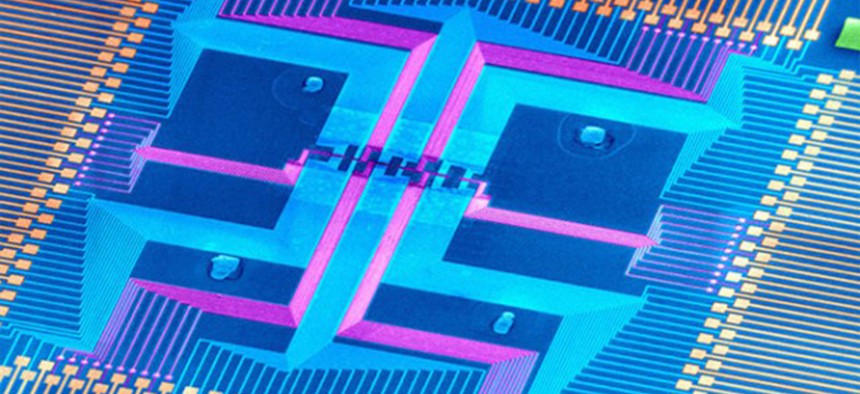These Molecule-sized Wires Could Stop the Computer Industry From Hitting a Brick Wall

The DNA-sized nanowires in the center of this magnified chip could keep the electronics industry from burning out. MITRE
The nanoFSM saves power, and creates less heat, through a combination of size and design.
In case you missed it, the end of the age of ever-faster computers is nigh. In his speech (pdf) at last summer’s Hot Chip conference, Bob Colwell, Intel’s former chief architect, said Moore’s law—the prediction that computer power doubles every 18-24 months, which has held largely true since Intel co-founder Gordon Moore made it in 1965—will cease to hold by 2020.
Colwell’s prognosis is dire, but not everyone is accepting it. On Jan. 23, a joint team from Harvard and the non-profit defense contractor MITRE challenged the repeal of Moore’s law with an ultra-dense, nano-scale processor that could add time to computing’s Doomsday Clock.
The sheer number of circuits that can fit on a processor is called the transistor count. Generally speaking, Moore’s law states that processors will double their transistor count every couple of years. A transistor is basically a switch that both stores and processes data; the more of them a computer contains, the more memory and power it has.
The problem is, processors are built with silicon. As silicon transistors get more and more dense, they need more power and better cooling. In other words, it’s not that we can’t design faster chips, it’s just too expensive and difficult to keep them running.
The Harvard/MITRE team’s chip—called the nanoFSM—saves power, and creates less heat, through a combination of size and design. Not only do the tiny wire transistors need less energy, but they are “nonvolatile.” This means that they don’t need a constant electrical current to remember how they’ve been programmed, unlike regular transistors. The nanowires are so-named because they are measured on the nanometer scale, along with DNA and viruses. Where an Intel Core i7—a chip at the heart of high-end personal computers—is roughly the size of a small coin, the prototype nanoFSM would be a speck of dust on the coin’s face (though it’s also less powerful).
Computers can’t keep getting faster forever, but it’s no surprise that the industry wants to stave off the end of the Moore’s law era as long as it can. Without the constant doubling of computer power we wouldn’t have iPads, IBM’s Watson supercomputer, or the internet. Engineers started worrying about the end of Moore’s law around 2005, when the ever-smaller chips stopped being able to outrun the laws of physics that govern heat dissipation.
Nanowires aren’t new, but this is the first time they’ve been made into transistors that can do math and remember information. This technically makes the nanoFSM a computer, but barely so. Currently, the chip is little more sophisticated than all but the earliest digital processors. If it’s going to save Moore’s law, nanoFSM’s creators still need to prove that they can scale this technology up to handle heavier workloads without succumbing to the same problems that threaten the law now—let alone completely new ones.
Reprinted with permission from Quartz. The original story can be found here.



